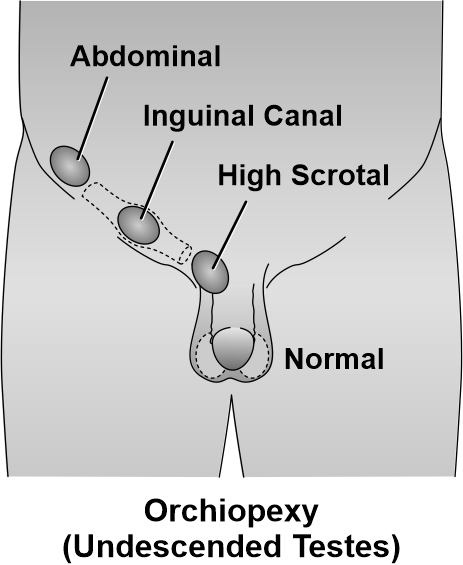Orchiopexy
What is Orchiopexy Surgery?
Orchiopexy (or-kee-oh-PEK-see) is a surgical procedure to treat undescended testicles. The procedure is done to move testicles from the abdomen or groin into the scrotum.
What causes undescended testicles?
Before birth, the testicles move from the pelvic area down into the scrotum. In some boys, this does not occur and it is called undescended testicles (see education sheet titled “Undescended testis”). Some boys can be diagnosed later in life with ectopic (a testicle outside the scrotum) or retractile (testicle that moves back and forth from the scrotum) and may also need surgical repair.

How is it diagnosed?
Your doctor will ask questions about symptoms and do a physical examination.
When is surgery needed?
Surgery is usually done in childhood, shortly after diagnosis is made. This may require more than one procedure depending on other problems and the position of the testes. If undescended testicles are left too long, changes can occur which can affect growth, function and potentially increase risk for cancer growth later in life.
What happens during surgery?
Your son will receive a general anesthetic to help him sleep and not feel pain during the surgery. A local block (numbing medicine around the surgical area) will be given. Small cuts are made in the groin and scrotum and the testicle(s) are brought down into the scrotum and stitched in place. In most cases a laparoscope (small camera) is used to examine the pelvis and to help find and move the testis. This can also help your surgeon plan for future surgeries to fix other problems. Usually surgery is done on an outpatient basis, and your son will be discharged the same day.
Will my child be in pain?
Most children do well with the surgery. If your child is in pain, a pain medicine can help. You may alternate Acetaminophen (Tylenol® or another brand) and Ibuprofen (such as Advil® or Motrin®). Do not give aspirin because it may cause bleeding.
What can I expect after the surgery?
Before your child is discharged you will be given written information about their care at home and any questions you have will be answered.
- Diet: Resume regular diet as tolerated
- Activity: Your child may return to school or daycare when pain is well controlled. Avoid straddling activities, contact sports and swimming for 14 days.
- Wound care: Expect swelling, bruising and redness of the scrotum and groin. Minor bleeding or spotting at incisions is not unusual. Your surgeon will explain any dressing cares.
- Bathing: It is ok to take a bath 24 hours after procedure. Bathe (5-10 minutes) in plain water for the next 7 days. A daily warm bath will help the healing and provide comfort.
- Medicines: You may alternate Acetaminophen (Tylenol® or another brand) and Ibuprofen (such as Advil® or Motrin®). Do not give aspirin because it may cause bleeding.
What to call the surgeon for:
- Fever with redness or drainage at surgical site
- Significant swelling, bruising or bleeding at surgical area
- If the wound starts separating
Call your primary care doctor for any other concerns.
Follow-up care:
Follow-up with your child’s surgeon as directed following the surgery. Call your surgeon’s office to schedule an appointment.
Questions?
This information is not specific to your child but provides general information. If you have any questions, please call your clinic
This page is not specific to your child, but provides general information on the topic above. If you have any questions, please call your clinic. For more reading material about this and other health topics, please call or visit Children's Minnesota Family Resource Center library, or visit www.childrensmn.org/educationmaterials.
© 2024 Children's Minnesota
